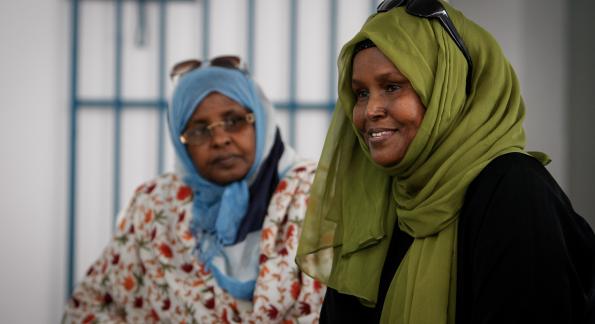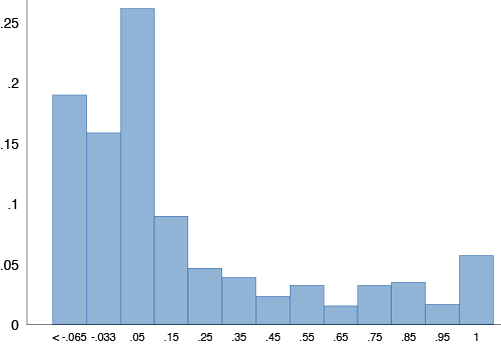
This article originally appeared in VoxEU.org | Article
Authors: Ingvild Almås, Alex Armand, Orazio Attanasio, Pedro Carneiro
Most conditional cash transfer programmes around the world target women as the recipients of transfers as a means of empowering them and promoting gender equality. However, the mechanisms at work are poorly understood and empowerment is not well defined or measured. This column discusses a new measure of female empowerment in the household within the context of a national cash transfer programme in Macedonia. Whereas conventional survey questions about power and decision-making don’t reveal any empowerment effects of the programme, this new measure reveals a positive effect.
The Sustainable Development Goals, recently approved by the UN, highlight the importance of women’s empowerment for the Post-2015 Development Agenda and set an ambitious goal – to achieve gender equality and empower all women and girls. One sphere where gender inequality is materialised is the household, making the empowerment of women within this environment a cornerstone for the fulfilment of this goal.
Transfers targeted to women have become a typical policy tool to promote female empowerment and are believed to increase women’s control over household resources. As a matter of fact, most conditional cash transfer programmes around the world select a woman in the family to be the recipient of the transfer (Fiszbein et al 2009). However, we still have a very limited understanding of the mechanisms at play, and the concept of empowerment, especially within the household, is not always well defined and measured. In the past few decades, many surveys have included batteries of questions aimed at measuring the gender balance and power over decision-making at home. A typical set of questions asks respondents to identify which family member is in charge of certain decisions, such as who decides about expenditures on different goods, or on investments in children, such as schooling. However, in many datasets, very limited variation is observed suggesting that these questions reveal only limited information about household decision-making. As a result, most research on this topic has focused on indirect measures such as observed shifts in household consumer choices, and not on a more direct assessment on female power.
One example of a program targeting women is PROGRESA/Oportunidades, a conditional cash transfer programme in Mexico. The PROGRESA evaluation survey included several questions on self-reported participation in household decision-making, such as “Who decides whether to enrol children in school?”. The possible answers to such questions were:
- The husband,
- The wife, or
- Both.
The large majority of households chose option (c) for most questions and such proportions were not significantly changed by the program (see for instance Adato et al. 2000). However many studies find that PROGRESA and other similar programs did shift household outcomes, such as consumption of food, in a substantive fashion (see for example, Attanasio and Lechene 2014), suggesting that a change in power may have taken place.
In order to better understand the effect of targeted transfers on gender equalisation and female empowerment, there is a need for better measures.
Assessing empowerment through a lab experiment
In a recent paper (Almås et al. 2015), we propose an alternative quantitative measure of women’s empowerment within the household. This measure is based on observing women’s choices in a laboratory setting. The woman reveals how much she is willing to pay to receive a transfer instead of her husband receiving it. In the survey, the willingness to pay is inferred from a number of choices the woman is asked to make. All choices are incentivised, meaning that we are offering a real transfer and that the woman’s choices will have consequences on whether she or her husband receives it.
The idea is that a transfer does not only affect the economic opportunities by increasing household income, but it typically also alters the distribution of power over resources since it is transferred to a specific household member. The measure we suggest provides information about how women are willing to trade off household income in order to gain control over resources; that is, her willingness to pay gives us a measure of how her power changes with a transfer. The fact that a woman is willing to pay a substantial fraction of a fraction so that she (rather than her husband) has control over it indicates that she has relatively low power within the household. Conversely, a woman who is willing to pay very little to gain control should have more power within the marriage.
We implemented the experiment among women living in poor households in urban areas of Macedonia. We find a great degree of heterogeneity in women’s willingness to pay in order to avoid that their husband receives the transfer, ranging from a zero share of the total transfer to the total transfer offered. A large share of women is willing to pay a significant share and on average the women are willing to pay around 20% of the offered transfer in order to gain control over resources (Figure 1).
Figure 1. Distribution of willingness to pay

Do gender-targeted transfers empower women?
We use our measure and results from the experiment to study the empowerment effect of the targeted cash transfers provided by the Macedonian nationwide ‘Conditional Cash Transfer (CCT) for Secondary School Education’, a cash transfer programme supporting secondary school enrolment across poor households. The CCT programme was in place for the three years prior to our lab experiment. In 50 randomly chosen towns of the 100 where the CCT was implemented, the transfer was received by the woman in the household, while in the remaining 50 the recipient was the household head (generally the man). The random assignment of the payment provides us with an exogenous source of variation that enables us to identify the empowerment effect of targeted transfers using our lab data.
Our measure indicates that the CCT programme had a significant impact on women’s power in the household. In particular, we see that those women living in municipalities where payments were offered exclusively to women were willing to pay less to get control of the transfer in the lab experiment. In addition to the experiment, we also collected responses to the much used survey questions on empowerment. As with other evaluations, measures based on these questions do not reveal any empowerment effect of the program, a result pointing to the need for alternative measures of empowerment, ours being one such measure.
Why do gender-targeted transfers empower women?
Although policy interventions shifting the relative income of women versus men within households have been shown to have an effect on different family decisions (Lundberg et al. 1997, Ward-Batts 2008, Attanasio and Lechene 2002, 2014), evidence on the exact mechanism linking targeted transfers to women and their empowerment has been limited.
Our measure of empowerment can be interpreted within several existing model frameworks, among them different version of the so-called collective household models (Chiappori 1992, Browning and Chiappori 1998), but also extensions allowing for hiding of resources (supported by findings such as those of Ashraf 2009). In the future, our measure combined with an appropriate model framework will help us to examine further the mechanisms through which targeted transfers lead to the empowerment of women.
References
Adato, M, B de la Briere, D Mindek and A R Quisumbing (2000) The impact of PROGRESA on women’s status and intra-household relations, Technical report, IFPRI.
Almås, I, A Armand, O Attanasio and P Carneiro (2015) “Measuring and changing control: Women's empowerment and targeted transfers”, CEPR Discussion paper, DP10973.
Attanasio, O and V Lechene (2002) “Tests of income pooling in household decisions”, Review of Economic Dynamics, 5(4): 720–748.
Attanasio, O and V Lechene (2014) “Efficient responses to targeted cash transfers”, Journal of Political Economy, 122(1): 178–222.
Ashraf, N (2009) "Spousal control and intra-household decision making: An experimental study in the Philippines”, American Economic Review, 99(4): 1245–1277.
Browning, M and P-A Chiappori (1998) “Efficient intra-household allocations: A general characterization and empirical tests”, Econometrica: 1241–1278.
Chiappori, P-A (1992) “Collective labor supply and welfare”, Journal of Political Economy: 437–467.
Fiszbein, A, N R Schady and F H Ferreira (2009) “Conditional cash transfers: Reducing present and future poverty”, World Bank Publications.
Lundberg, S J, R A Pollak and T J Wales (1997) “Do husbands and wives pool their resources? Evidence from the United Kingdom child benefit”, Journal of Human Resources: 463–480.
Ward-Batts, J (2008) “Out of the wallet and into the purse using micro data to test income pooling”,Journal of Human Resources, 43(2): 325–351.






